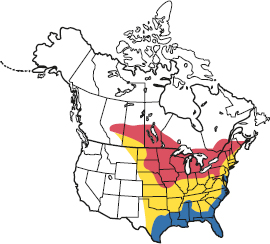Cistothorus platensis

adult
Although similar to a Marsh Wren, a Sedge Wren can be identified using plumage features, voice, and habitat. The sexes are similar. Adults have brown upperparts that are extensively but finely streaked on the crown and back, with dark barring on the tail. The underparts are buff, palest and whitish on the throat. The rufous wings are strongly barred and the head has a pale supercilium. Juveniles are similar to adults but less colorful.
The Sedge Wren is a breeding visitor to central northern North America, where it is present mainly from May to September. After breeding, it migrates south and at other times of the year it is found in southeast U.S.A., where it occurs in coastal marshes as well as inland freshwater wetlands. It is generally unobtrusive and its presence is easiest to detect by listening for its call or song.

adult
FACT FILE
LENGTH 4.5 in (11.5 cm)
FOOD Invertebrates
HABITAT Marshes and wet meadows where sedges flourish
STATUS Locally common migrant in both summer and winter
VOICE Song comprises a few sharp chip, chip notes followed by a dry rattle. Call is a sharp chip
![]()
